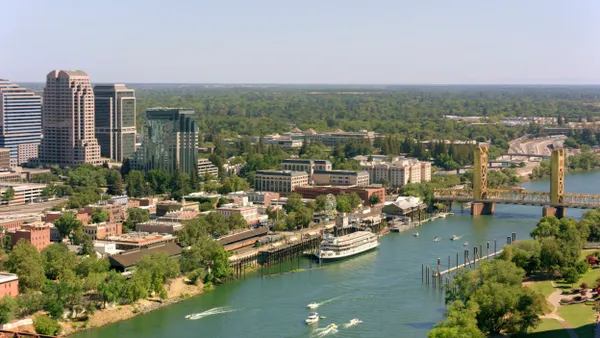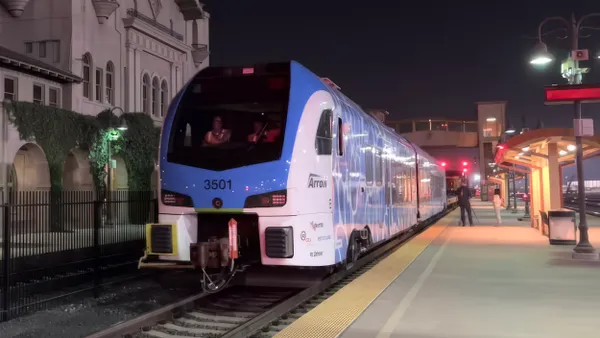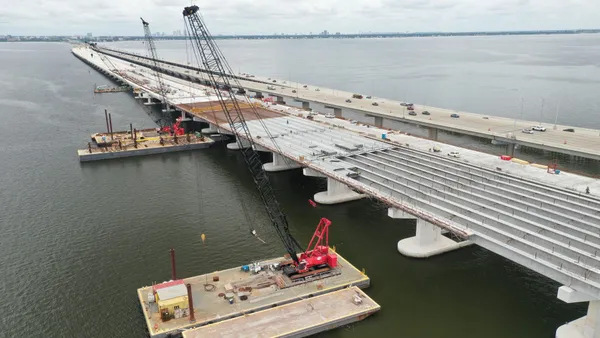UPDATED, Sept. 23, 2019: Uber sued New York City late last week to try and overturn limits on the amount of time drivers spend without passengers in their cars, known as deadheading. The rule that Uber is challenging requires drivers to reduce deadheading time from 41% to 31% in Manhattan below 96th Street.
The suit also challenges the extension on a licensing cap, approved by the Taxi and Limousine Commission in August.
The Verge notes it is the second time this year Uber has sued the city.
Dive Brief:
- Uber CEO Dara Khosrowshahi said Thursday New York City's decision to extend its cap on the number of ride-hailing vehicles permitted to operate is making mobility unavailable in some parts of the city.
- New York's Taxi and Limousine Commission (TLC) voted earlier this week to extend the cap brought in last summer, and also cut the amount of time drivers spend without passengers in their cars — known as deadheading — from 41% to 31%. On Uber's Q2 2019 earnings call the company reported quarterly losses of $5.2 billion in part due to stock buy-backs after its initial public offering (IPO). Khosrowshahi said price increases due to the rules are hitting lower-income parts of New York hardest.
- "I think anyone who thinks that the changes — who tells you that the changes in New York City are good is malarkey frankly," Khosrowshahi said during the call. He added that the rules are creating "another medallion system," which has come under fire for keeping taxi drivers under crushing debt and driving them to suicide.
Dive Insight:
New York City's ride-hailing regulations, the first to be passed in the United States, have been under fire from Uber and Lyft from the start, with the companies accusing the TLC and New York City Council of undermining transportation equity and driving up prices.
Business continues to grow in New York City thanks to higher-income areas where people can afford price increases, but East New York, Wakefield, the Bronx and Central Harlem are seeing declines in usage, Khosrowshahi said on the call.
Khosrowshahi also criticized the decision to set a minimum wage for ride-hailing companies, another part of the regulations approved by the city council and then set at $17.22 an hour by the TLC at the end of 2018.
He said that Uber is an "open labor system," and the rules make it difficult for drivers to fan out across the city and make money everywhere.
"We've always been available to anybody who wants to find labor on our system, make money on our system, any which way they can," Khosrowshahi said. "And the new rules could potentially restrict where, when, how drivers can work."
In a statement, New York City Mayor Bill de Blasio disputed those allegations. He said the rules "have resulted in increased wages and families finally have some relief," and mean the city "will not let big corporations walk all over hardworking New Yorkers and choke our streets with congestion."
Despite those difficulties in New York City, Khosrowshahi said that Uber wants to be a strong partner with cities, especially around transit. It has integrated public transportation information into its app in Boston and Denver. Uber's partnership with Cincinnati has received high praise after its first year in operation. That integration and the introduction of more transportation options like dockless bikes and scooters has brought with it more engagement with its app, so Khosrowshahi said there is reason for optimism.
"As we add in more transportation options, we become a factor in a larger percentage of the population's transportation decisions," he said. "[We] think it’s good for consumers, we think it's good for us and we think it's good for mass transit and the city as well."











